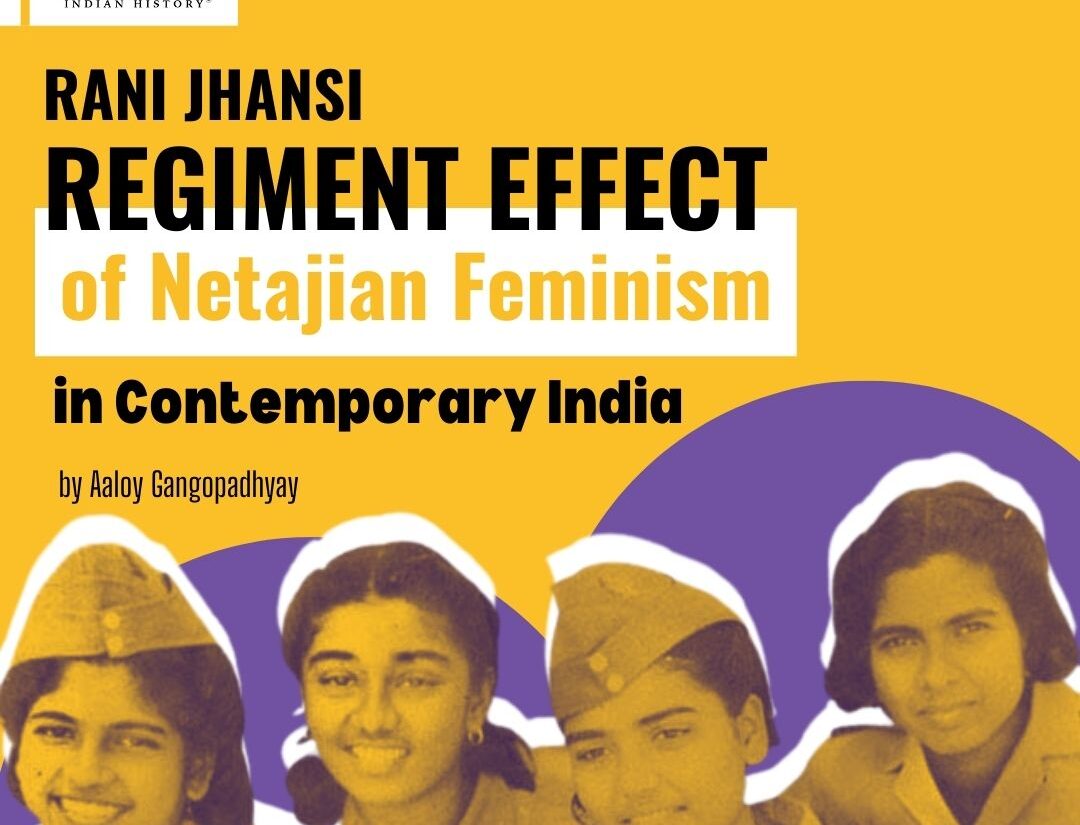Rani Jhansi Regiment: Effect of Netajian Feminism in Contemporary India
- EIH User
- February 28, 2023

Article Written By EIH Researcher And Writer
Aaloy Gangopadhyay

Netaji Subhas Chandra Bose and Captain Lakshmi Sahgal with members of the Indian National Army’s Rani Jhansi Regiment
Women’s Day is not meant by giving social media posts with #women’s day. The contributions of women for a nation’s progress are determined by the fact how much they carry adaptability to situations, commitment, enthusiasm, tenacity, respect, motherliness and sacrifice. The 21st century is very much determined by antagonistic attitudes towards males or complaining attitudes towards religions and patriarchy. Even the contribution of males who promoted feminism are looked down upon or forcefully forgotten. Netajian Feminism has been forgotten due to many reasons. It promoted constructive feminism based on equality among men and women with an attitude of sacrifice towards development of a nation. It believes with unbiased faith and respect towards the constitution. It enhances solving day to day problems collectively with the process of practicing democracy in decision making. He started his idea of feminism with his army of independence known as Indian National Army or Azad Hind Fauj.
The Rani of Jhansi Regiment was the Women’s Regiment of the Indian National Army, with the aim of overthrowing the British Raj in colonial India. It was one of the all-female combat regiments of the Second World War. Led by Lakshmi Sahgal, the unit was raised in July 1943 with volunteers from the expatriate Indian population in SouthEast Asia. The unit was named the Rani of Jhansi Regiment after Lakshmibai, Rani of Jhansi. Netaji Subhash Chandra Bose announced the formation of the Regiment on 12 July 1943.Most of the women were teenage volunteers of Indian descent from Malayan rubber estates; very few had ever been to India. The initial nucleus of the force was established with its training camp in Singapore with approximately a hundred and seventy cadets. The cadets were given ranks of non-commissioned officer or sepoy (private) according to their education. Later, camps were established in Rangoon and Bangkok and by November 1943, the unit had more than three hundred cadets.
Training in Singapore began on 23 October 1943.The recruits were divided into sections and platoons and were accorded ranks of Non-Commissioned Officers and Sepoys according to their educational qualifications. These cadets underwent military and combat training with drills, route marches as well as weapons training in rifles, hand grenades, and bayonet charges. Later, a number of the cadets were chosen for more advanced training in jungle warfare in Burma. The Regiment had its first passing out parade at the Singapore training camp of five hundred troops on 30 March 1944. Some 200 of the cadets were also chosen for nursing training, forming the Chand Bibi Nursing Corps

March Past by Rani Jhansi Regiment
During the INA’s Imphal campaign, an initial contingent of nearly a hundred of the Rani of Jhansi troops moved to Maymyo, part of which was intended to form a vanguard unit to enter the Gangetic plains of Bengal after the expected fall of Imphal. A part of the unit also formed the nursing corps at the INA hospital at Maymyo. Following the failure of the siege of Imphal, The Rani of Jhansi Regiment of the Indian National Army (INA) was raised and trained in Japanese-occupied Malaya and Singapore in 1943-45. It saw action against the Allies in Burma during 1944-45.
This is the first history of the remarkable Regiment made up of young Indian women from towns and rubber plantations. Many had left comfortable lives to take part in this liberation struggle. The girls who had never seen India yet, were eager to enlist to liberate India from colonial bondage. It was one of the very few all-female combat regiments of the Second World War on any side. It was led by Captain Lakshmi Swaminathan Sahgal.
He said in one of his speeches, “I want also a unit of brave Indian women to form a ‘Death-defying Regiment’ who will wield the sword, which the brave Rani of Jhansi wielded in India’s First War of Independence in 1857.”
He reiterated his words several days later at a meeting of Indian women held under the aegis of the Women’s Section of the Indian Independence League (IIL). A female guard of honor was organized for Bose. Close to 20 women were persuaded to train to present arms using Lee-Enfield 303 rifles borrowed from the INA. There was little time to stitch uniforms, so women wore white saris. Indian women had already been a part of the freedom struggle. Much like today, the idea of having women in combat roles shocked men.

TOITOI
Rani Chhaganlal Mehta at target practice
Rani of Jhansi Regiment was formed as an all-woman soldiers unit under the Azad Hind Fauj. By the time Rani of Jhansi Regiment was formally inaugurated on October 22, 1943, on Singapore’s Waterloo Street, Janaki was an integral part of INA’s 500 ‘fighting Ranis’.
Recruitment of women soldiers mainly depended upon oppressed, suppressed, poor Tamil plantation workers of Malaya, Singapore and Burma. Historians and researchers put the number of women in the regiment as high as 5,000, although a clear estimate is unavailable. It is difficult to analyze and impossible to generalize why women enlisted in the Rani of Jhansi Regiment. Some Ranis stated their reasons concisely and probably with reasonable accuracy. Others seem to have been swept up by complicated emotions, resorting subsequently to the explanation that was most often cited by other Ranis. The question, “Why did you join the Ranis?” was almost always at first answered, “To fight for India’s freedom” and “To free our Motherland.” Most of the Ranis told me that they had felt a deep desire to answer Bose’s call and to make a positive contribution to justice for India. As a fifteen-year-old, Rasammah Navarednam read about the 1919 killing of unarmed civilians in the banned book, Jallianwala Bagh–The Amritsar Massacre. A year later that account influenced her decision to join the Ranis.

Women Contingent of Indian Army at Parade March Past
Indian armed forces began inducting women officers in 1992. Over the years, they have been assigned combat roles in the Air Force. Women have been inducted as fighter pilots and have flown sorties in combat zones. A 24-year-old became the navy’s first woman maritime reconnaissance pilot. Women have worked here as doctors, nurses, engineers, signalers, administrators and lawyers. They have been given a permanent commission. In 2019, they were cleared to join the military police. Currently, only a few more than a dozen countries allow women in combat roles. There’s no denying the fact that a woman’s and a man’s physical capabilities vary significantly, but those who are capable, must be given an opportunity.
The opportunity for women can be given only when Netajian feminism is followed in contemporary India where the values of communitarian selflessness, courage, fearlessness, self sufficiency, rationality, integrity, respect and sacrifice must be put to practice. Though women soldiers are given duties in Siachen and in rugged terrains, still they should be given more participation in combat activities, warfares, rescue operations, surgical strikes and decision making processes in the army.
Bibliography
“Women at War: Subhash Chandra Bose & Rani of Jhansi Regiment” by Vera Hildrebrand
“A Revolutionary Life: Memoirs of a Political Activist” by Lakshmi Sahgal
“Women Against The Raj: The Rani of Jhansi Regiment” by Joyce Chapman Lebra
“75th Anniversary of Indian National Army and Provisional Government” Edited by Purabi Roy
Web References
https://amritmahotsav.nic.in/freedom-movement-detail.htm?13
https://www.thehindu.com/society/history-and-culture/women-in-command-remembering-the-rani-of-jhansi-regiment/article30999665.ece
https://biblioasia.nlb.gov.sg/vol-14/issue-1/apr-jun-2018/warrior-women-rani/
https://caravanmagazine.in/vantage/women-bose-rani-jhansi-regiment
https://www.indiatimes.com/news/india/looking-back-77-years-ago-when-india-had-an-all-female-rani-jhansi-regiment-in-boses-azad-hind-fauj-506561.html#:~:text=Rani of Jhansi Regiment was, men in the armed
https://www.youthkiawaaz.com/2010/07/netaji-subhas-chandra-boses-views-on-women/


















